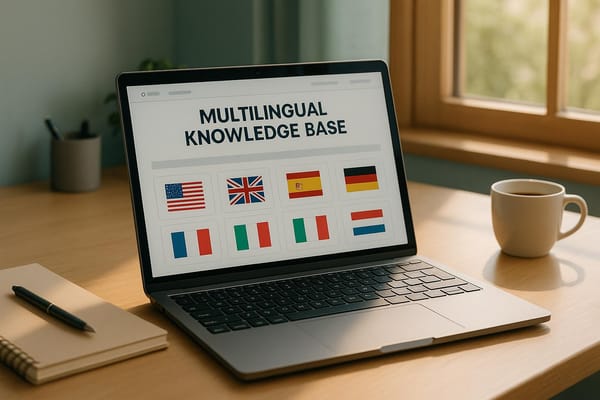How Translation APIs Improve Multilingual Knowledge Bases
Translation APIs streamline multilingual content management, saving time and ensuring consistency across languages for global audiences.

Translation APIs make it easy to manage multilingual content. They automate translations, saving time and money while ensuring consistency across languages. Here’s what you need to know:
- What They Do: Translate text, detect source languages, and maintain formatting (e.g., HTML, Markdown).
- Why They’re Useful: Reduce errors, speed up updates, and support global scaling.
- Key Features:
- Real-time and bulk translation options.
- Support for various content formats (e.g., rich text, JSON).
- Tools for managing language versions and tracking changes.
- Platforms Like HelpJam: Offer AI tools to streamline translations and maintain consistent terminology.
Translation APIs ensure your knowledge base is always up-to-date and accessible to global audiences. They’re a practical way to expand into new markets while improving user experience.
Translation API Basics
Translation APIs use advanced algorithms to process multilingual content while keeping the original context and meaning intact. Here’s a breakdown of key features like translation methods, language detection, and content format compatibility.
Instant vs. Bulk Translation Methods
Translation APIs offer two main methods to suit different needs:
Instant Translation
- Provides real-time translations for quick updates.
Bulk Translation
- Processes large volumes of content in one go, ideal for batch tasks.
Source Language Detection
Modern translation APIs are equipped with smart language detection tools that:
- Automatically identify the source language with a high level of accuracy.
- Analyze the text structure to ensure context is understood.
- Preserve formatting, including special characters.
- Maintain HTML tags and other rich text elements.
These capabilities help ensure translations stay true to the original message.
Content Type Support
Translation APIs are versatile and can handle a variety of content formats:
| Content Type | Features |
|---|---|
| Rich Text | Retains formatting, images, and embedded media. |
| HTML/XML | Preserves tags and structural integrity. |
| Plain Text | Processes basic text content efficiently. |
| Markdown | Keeps formatting syntax intact. |
| JSON/YAML | Handles structured data formats seamlessly. |
When paired with platforms like HelpJam, these APIs maintain the layout of articles, embedded media, category structures, and even AI training materials.
Setting Up Translation APIs
Follow these steps to configure translation APIs effectively.
API Setup Steps
- API Authentication Setup: Secure your credentials and tokens to ensure safe access.
- Environment Configuration: Prepare separate environments for development, staging, and production. Testing in these environments helps catch formatting issues and other errors early.
- Content Mapping: Align content elements with API parameters using the table below:
| Content Element | API Mapping |
|---|---|
| Article Title | Primary field for translation |
| Body Content | Supports HTML/Markdown formatting |
| Meta Description | Character-limited field |
| Categories/Tags | Reference field preservation |
Webhook Configuration
Webhooks are critical for automating translation processes. They allow you to:
- Trigger translations when a new article is created
- Set up callbacks for notifications when translations are completed
- Handle errors and retries efficiently
- Track the status of translation jobs in real-time
Language Version Control
Once the API is connected and automated processes are in place, manage language versions using the following strategies:
Version Tracking Table
| Feature | Purpose |
|---|---|
| Language Tags | Identify source and target languages |
| Version History | Track changes across translations |
| Sync Status | Monitor translation progress |
| Update Timestamps | Record last modification dates |
HelpJam’s pricing plans support multiple language versions. When managing language versions, pay attention to:
- Keeping formatting consistent across all translations
- Monitoring and updating statuses for each language variant
- Running quality checks before publishing
For faster and accurate translations, consider using HelpJam’s AI Co-pilot. This tool can translate entire articles quickly while preserving the original structure and formatting.
Translation API Advantages
Translation APIs simplify managing multilingual content, offering practical benefits for modern content workflows. Here's how they can make a difference:
Save Time and Cut Costs
Automating translations can significantly reduce the time and money spent on manual processes. With translation APIs, you can:
- Spend less on translations compared to traditional methods
- Speed up publishing by skipping manual copy-pasting
- Ensure consistent translations across multiple languages
These efficiencies make it easier to expand into global markets.
Support Growth
Translation APIs not only save resources but also help businesses tap into new opportunities.
Reaching New Markets
- Quickly launch support content tailored for different regions
- Automatically adjust content to fit local preferences
- Expand your multilingual content without hiring extra team members
Enhanced Customer Experience
- Give customers immediate access to materials in their language
- Keep a unified brand voice across all regions
- Provide real-time updates so all translations stay current
Focus on Quality
Efficiency doesn’t mean sacrificing quality. Translation APIs help maintain high standards by:
- Handling technical terms, brand names, and specific vocabulary consistently
- Ensuring accuracy across all translated content
- Keeping support materials clear and reliable for all audiences
Translation in HelpJam

HelpJam simplifies managing multilingual knowledge bases with AI-driven translation tools and user-friendly controls. Here's a closer look at how these features work to streamline content translation.
AI Translation Process
HelpJam uses advanced AI translation paired with smart workflow tools. The platform's AI Co-pilot supports you by:
- Translating Articles Instantly: Quickly convert content into multiple languages.
- Assisting with Content Creation: Generate or refine articles for better readability.
The system preserves your content's formatting and structure across languages, ensuring a consistent look and feel for your knowledge base. This smooth process lays the groundwork for managing terms effectively across all versions.
Term Management
Consistent terminology is key to maintaining your brand's voice. HelpJam's term management system includes:
| Feature | Purpose | Benefit |
|---|---|---|
| Custom Domains | Keeps branding consistent | Display translated content on your domain. |
| Unlimited Categories | Organizes content | Group related articles in any language. |
| AI-powered Suggestions | Ensures term uniformity | Maintain consistent terminology. |
| Translation View | Enables oversight | View all language versions at once. |
Translation Metrics
Translation metrics provide insights to refine both AI translations and term management, helping improve multilingual content delivery.
Performance Tracking
- Analyze customer interaction with translated content.
- Pinpoint the most popular language versions.
- Track search behavior across various languages.
Content Gap Analysis
HelpJam identifies what users are searching for in each language, revealing where additional translations or new content are needed. This data-first strategy helps focus translation efforts for better coverage.
Conclusion
Translation APIs simplify the process of managing multilingual knowledge bases, making global support more efficient. By automating translations, companies can save both time and money while maintaining consistency across languages.
When combined with tools like HelpJam, the localization process becomes even smoother. HelpJam provides flexible pricing options, ranging from a Free plan to packages that support unlimited languages.
AI-powered translation brings key benefits, including faster implementation, cost savings, and consistent brand messaging. Features like automated terminology management and seamless content updates ensure translation quality across different languages. These advantages highlight the importance of automated translation systems.
Integrating translation APIs with content management platforms is a practical step toward delivering reliable multilingual support.
FAQs
How do translation APIs maintain accurate and consistent multilingual content?
Translation APIs ensure accuracy and consistency by using advanced technologies like machine learning and natural language processing. These tools help deliver precise translations while maintaining the intended tone and context of the original content.
Platforms like HelpJam enhance this process further by offering a multilingual knowledge base that simplifies the creation and management of translated materials. This ensures your global audience receives clear, reliable information tailored to their language and cultural preferences.
How do HelpJam's AI tools simplify managing multilingual knowledge bases compared to manual translation?
HelpJam's AI tools streamline the process of managing multilingual knowledge bases by making translations faster, more accurate, and easier to scale. With features like an AI-powered rich text editor, you can quickly create or translate articles while maintaining high-quality content. The built-in AI copilot assists with writing, ensuring clarity and consistency across languages.
Additionally, HelpJam enables seamless translation into multiple languages, allowing you to support customers in their preferred language effortlessly. This not only saves time but also enhances the customer experience by providing accurate and localized information.
How can businesses use translation APIs to manage multilingual content and expand their global reach?
Businesses can integrate translation APIs into their content management systems to streamline the creation and management of multilingual content. By automating translations, these APIs help ensure consistency and save time, making it easier to maintain an up-to-date knowledge base in multiple languages.
Platforms like HelpJam simplify this process by offering a multilingual knowledge base feature. This enables businesses to deliver localized content efficiently, improving accessibility for global audiences and enhancing customer support across different regions.





